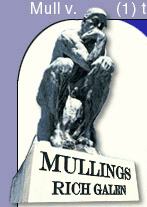|
|

|


All About Bean Sprouts
Rich Galen
Monday June 6, 2011
Click here for an Easy Print Version
The E. Coli outbreak in Europe now appears to have been caused by bean sprouts. If the strain weren't so deadly (as of last night it has killed 22 people and sickened at least 2,100 including more than 600 in intensive care), it would be amusing.
But it is, so it's not.
According to the Centers for Disease Control, this strain of E. Coli (the "E" is short for Escherichia) has caused "520 patients to exhibit hemolytic uremic syndrome (HUS) - a type of kidney failure."
The CDC also reports on its webpage that
"In the United States, four suspected cases of infections have been identified in persons who recently traveled to Hamburg, Germany, where they were likely exposed."
They report one case each in Massachusetts, Michigan, and Wisconsin, with the fourth case still under investigation.
In addition, given the huge footprint of U.S. Service Members in Germany, the Department Defense is tracking the outbreak. Two Service Members in Germany have exhibited some of the symptoms and are under observation.
The particular sprouts in question appear to have come from one organic farm in Germany. Before you stick your index finger in the air and proclaim "Ah HAH!" because of the organic business, it appears that the bacterium is most likely deposited on the leaves or stems of plants from run off containing manure from infected animals.
Remember the spinach E. Coli outbreak in 2006? It has been reported that its source was feral (wild) pigs whose manure washed downstream to a farm which grew the lettuce.
A lot of bugs live in soil. Anthrax was high on the hit parade about 10 years ago, as you might remember. In a 2006 article in Slate Magazine, writer Constance Casey looked at the way the root systems of plants take up nutrients from the soil:
Water and nutrients come in through the root hairs, threadlike, thin-walled vessels similar to our capillaries.
These hairs take up nitrates, potassium, and other substances in ion form. These are little atom groups. A one-celled bacterium, by contrast, is generally too big to be absorbed by roots. That's pretty crucial to the food chain, because soil is alive with bacteria; if the plants we eat took up the critters regularly through the roots, they'd be chock-full of pathogens and we'd be sick all the time.
In a New York Times piece published last night, reporters Rudy Dempsey and William Neuman wrote:
"Bacteria can flourish in the warm, humid conditions in which sprouts are grown. Investigators have sometimes found that the seeds used to grow sprouts are contaminated with bad bacteria, like E. coli or salmonella. Once those seeds start growing, the bacteria can easily spread.
This next section was to deal with bean sprouts in particular. I thought it might be interesting to list some recipes in which bean sprouts are used.
It is a reflection on the state of my culinary and gastronomic ignorance that when I came across this article on bean sprouts nutrition information from the Livestrong.com website.
"When 'bean sprout' is mentioned, many immediately think of the mung sprouts used in traditional Asian cuisine."
I have had bean sprouts in Chinese food, but I did not know they were known as "mung sprouts." You may safely assume that E. Coli or not, something called "mung" is not likely to pass my lips ever again.
It turns out that bean sprouts are really the baby form of beans. Who knew?
The article lists kidney, navy, pinto, lentil, soy, and the aforementioned mung beans.
But, other sprouts, according to that NY Times report, are vegetables of interest "including broccoli, peas, chickpeas, garlic, lentils, and radishes."
Bean sprouts are a good source of vitamins and minerals. Vitamin C most of the eight B vitamins, folate, thiamine, as well as riboflavin, niacin. They are also rich sources of omega-3 and omega-6 fatty acids.
In any event, your mom's admonition to wash your hands before you cook and eat; and wash vegetables before you put them on the salad plate is probably still the best defense against E. Coli.
On the Secret Decoder Ring today: Bushels of links to all the information above. Also a Mullfoto from the dock in Alexandria, Virginia and a head-scratching Catchy Caption of the Day.
--END --
Copyright © 2011 Barrington Worldwide, LLC
Become a
Paid Mullings Subscriber!
(To join the FREE mailing list or to unsubscribe Click Here)

Current Issue |
Secret Decoder
Ring | Past
Issues | Email
Rich | Rich
Who?
Copyright �2007 Barrington Worldwide, LLC | Site design by Campaign
Solutions. | |
|


